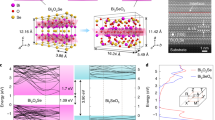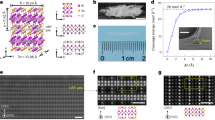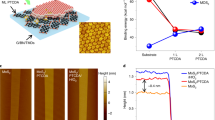Abstract
Two-dimensional (2D) semiconductors are promising channel materials for next-generation field-effect transistors (FETs). However, it remains challenging to integrate ultrathin and uniform high-κ dielectrics on 2D semiconductors to fabricate FETs with large gate capacitance. We report a versatile two-step approach to integrating high-quality dielectric film with sub-1 nm equivalent oxide thickness (EOT) on 2D semiconductors. Inorganic molecular crystal Sb2O3 is homogeneously deposited on 2D semiconductors as a buffer layer, which forms a high-quality oxide-to-semiconductor interface and offers a highly hydrophilic surface, enabling the integration of high-κ dielectrics via atomic layer deposition. Using this approach, we can fabricate monolayer molybdenum disulfide-based FETs with the thinnest EOT (0.67 nm). The transistors exhibit an on/off ratio of over 106 using an ultra-low operating voltage of 0.4 V, achieving unprecedently high gating efficiency. Our results may pave the way for the application of 2D materials in low-power ultrascaling electronics.
This is a preview of subscription content, access via your institution
Access options
Access Nature and 54 other Nature Portfolio journals
Get Nature+, our best-value online-access subscription
$29.99 / 30 days
cancel any time
Subscribe to this journal
Receive 12 print issues and online access
$259.00 per year
only $21.58 per issue
Buy this article
- Purchase on Springer Link
- Instant access to full article PDF
Prices may be subject to local taxes which are calculated during checkout




Similar content being viewed by others
Data availability
The data that support the findings of this study are included in the article and Supplementary Information, and are available from the corresponding author upon reasonable request.
Code availability
All computational data are presented in the paper.
References
Akinwande, D. et al. Graphene and two-dimensional materials for silicon technology. Nature 573, 507–518 (2019).
Liu, Y. et al. Promises and prospects of two-dimensional transistors. Nature 591, 43–53 (2021).
Das, S. et al. Transistors based on two-dimensional materials for future integrated circuits. Nat. Electron. 4, 786–799 (2021).
Desai, S. B. et al. MoS2 transistors with 1-nanometer gate lengths. Science 354, 99–102 (2016).
Wu, F. et al. Vertical MoS2 transistors with sub-1-nm gate lengths. Nature 603, 259–264 (2022).
Fiori, G. et al. Electronics based on two-dimensional materials. Nat. Nanotechnol. 9, 768–779 (2014).
Li, W. et al. Uniform and ultrathin high-κ gate dielectrics for two-dimensional electronic devices. Nat. Electron. 2, 563–571 (2019).
Cheema, S. S. et al. Ultrathin ferroic HfO2–ZrO2 superlattice gate stack for advanced transistors. Nature 604, 65–71 (2022).
Badaroglu, M. International Roadmap for Devices and Systems 2021 (IEEE, 2021); https://irds.ieee.org/editions/2021/more-moore
Knobloch, T. et al. The performance limits of hexagonal boron nitride as an insulator for scaled CMOS devices based on two-dimensional materials. Nat. Electron. 4, 98–108 (2021).
Illarionov, Y. Y. et al. Insulators for 2D nanoelectronics: the gap to bridge. Nat. Commun. 11, 3385 (2020).
Radisavljevic, B. et al. Single-layer MoS2 transistors. Nat. Nanotechnol. 6, 147–150 (2011).
Liu, H. & Ye, P. D. MoS2 dual-gate MOSFET with atomic-layer-deposited Al2O3 as top-gate dielectric. IEEE Electron Device Lett. 33, 546–548 (2012).
Fang, H. et al. High-performance single layered WSe2 p-FETs with chemically doped contacts. Nano Lett. 12, 3788–3792 (2012).
Liu, K. et al. A wafer-scale van der Waals dielectric made from an inorganic molecular crystal film. Nat. Electron. 4, 906–913 (2021).
Jeong, S.-J. et al. Thickness scaling of atomic-layer-deposited HfO2 films and their application to wafer-scale graphene tunnelling transistors. Sci. Rep. 6, 20907 (2016).
Zhu, Y. et al. Monolayer molybdenum disulfide transistors with single-atom-thick gates. Nano Lett. 18, 3807–3813 (2018).
Takahashi, N. & Nagashio, K. Buffer layer engineering on graphene via various oxidation methods for atomic layer deposition. Appl. Phys. Express 9, 125101 (2016).
Zou, X. et al. Interface engineering for high-performance top-gated MoS2 field-effect transistors. Adv. Mater. 26, 6255–6261 (2014).
Lin, D. et al. Dual gate synthetic WS2 MOSFETs with 120 μS/μm Gm 2.7 μF/cm2 capacitance and ambipolar channel. In Proc. 2020 IEEE International Electron Devices Meeting (IEDM) 3.6.1–3.6.4 (IEEE, 2020).
Xu, K. et al. Sub-10 nm nanopattern architecture for 2D material field-effect transistors. Nano Lett. 17, 1065–1070 (2017).
Fisichella, G. et al. Interface electrical properties of Al2O3 thin films on graphene obtained by atomic layer deposition with an in situ seedlike layer. ACS Appl. Mater. Interfaces 9, 7761–7771 (2017).
Park, Y. H. et al. Enhanced nucleation of high-κ dielectrics on graphene by atomic layer deposition. Chem. Mater. 28, 7268–7275 (2016).
Zheng, L. et al. Improvement of Al2O3 films on graphene grown by atomic layer deposition with pre-H2O treatment. ACS Appl. Mater. Interfaces 6, 7014–7019 (2014).
Xiao, M., Qiu, C., Zhang, Z. & Peng, L.-M. Atomic-layer-deposition growth of an ultrathin HfO2 film on graphene. ACS Appl. Mater. Interfaces 9, 34050–34056 (2017).
Wang, X. et al. Improved integration of ultra-thin high-κ dielectrics in few-layer MoS2 FET by remote forming gas plasma pretreatment. Appl. Phys. Lett. 110, 053110 (2017).
Nayfeh, O. M., Marr, T. & Dubey, M. Impact of plasma-assisted atomic-layer-deposited gate dielectric on graphene transistors. IEEE Electron Device Lett. 32, 473–475 (2011).
Yang, W. et al. The integration of sub-10 nm gate oxide on MoS2 with ultra low leakage and enhanced mobility. Sci. Rep. 5, 11921 (2015).
Bolshakov, P. et al. Improvement in top-gate MoS2 transistor performance due to high quality backside Al2O3 layer. Appl. Phys. Lett. 111, 032110 (2017).
Jandhyala, S. et al. Atomic layer deposition of dielectrics on graphene using reversibly physisorbed ozone. ACS Nano 6, 2722–2730 (2012).
Wang, J. et al. Integration of high-κ oxide on MoS2 by using ozone pretreatment for high-performance MoS2 top-gated transistor with thickness-dependent carrier scattering investigation. Small 11, 5932–5938 (2015).
Park, J. H. et al. Atomic layer deposition of Al2O3 on WSe2 functionalized by titanyl phthalocyanine. ACS Nano 10, 6888–6896 (2016).
Alaboson, J. M. P. et al. Seeding atomic layer deposition of high-κ dielectrics on epitaxial graphene with organic self-assembled monolayers. ACS Nano 5, 5223–5232 (2011).
Sangwan, V. K. et al. Quantitatively enhanced reliability and uniformity of high-κ dielectrics on graphene enabled by self-assembled seeding layers. Nano Lett. 13, 1162–1167 (2013).
Bouchet, D., Roy, E., Yu-Zhang, K. & Leprince-Wang, Y. TEM and EELS studies of electrodeposited antimony nanowires. Eur. Phys. J. Appl. Phys. 30, 193–199 (2005).
Cui, X. et al. Multi-terminal transport measurements of MoS2 using a van der Waals heterostructure device platform. Nat. Nanotechnol. 10, 534–540 (2015).
Yang, J. et al. Direct observation of ultrafast hydrogen bond strengthening in liquid water. Nature 596, 531–535 (2021).
Shen, P. C. et al. Ultralow contact resistance between semimetal and monolayer semiconductors. Nature 593, 211–217 (2021).
Ghatak, S., Pal, A. N. & Ghosh, A. Nature of electronic states in atomically thin MoS2 field-effect transistors. ACS Nano 5, 7707–7712 (2011).
Cheng, L. et al. Sub-10 nm tunable hybrid dielectric engineering on MoS2 for two-dimensional material-based devices. ACS Nano 11, 10243–10252 (2017).
Li, W. et al. High-performance CVD MoS2 transistors with self-aligned top-gate and Bi contact. In Proc. 2021 IEEE International Electron Devices Meeting (IEDM). 37.3.1–37.3.4 (IEEE, 2021).
Qian, Q. et al. Improved gate dielectric deposition and enhanced electrical stability for single-layer MoS2 MOSFET with an AlN interfacial layer. Sci. Rep. 6, 27676 (2016).
Chamlagain, B. et al. Thermally oxidized 2D TaS2 as a high-κ gate dielectric for MoS2 field-effect transistors. 2D Mater. 4, 031002 (2017).
Li, T. et al. Epitaxial growth of wafer-scale molybdenum disulfide semiconductor single crystals on sapphire. Nat. Nanotechnol. 16, 1201–1207 (2021).
Plimpton, S. Fast parallel algorithms for short-range molecular dynamics. J. Comput. Phys. 117, 1–19 (1995).
Stukowski, A. Visualization and analysis of atomistic simulation data with OVITO–the Open Visualization Tool. Model. Simul. Mater. Sci. Eng. 18, 015012 (2009).
Humphrey, W., Dalke, A. & Schulten, K. VMD: visual molecular dynamics. J. Mol. Graph. 14, 33–38 (1996).
Rappe, A. K. et al. UFF, a full periodic table force field for molecular mechanics and molecular dynamics simulations. J. Am. Chem. Soc. 114, 10024–10035 (1992).
Tang, W., Sanville, E. & Henkelman, G. A grid-based Bader analysis algorithm without lattice bias. J. Phys. Condens. Matter 21, 084204 (2009).
Varshney, V. et al. MD simulations of molybdenum disulphide (MoS2): force-field parameterization and thermal transport behavior. Comput. Mater. Sci. 48, 101–108 (2010).
Nicolini, P. & Polcar, T. A comparison of empirical potentials for sliding simulations of MoS2. Comput. Mater. Sci. 115, 158–169 (2016).
Hockney, R. W. & Eastwood, J. W. Computer Simulation Using Particles (CRC Press, 1988).
Allen, M. P. & Tildesley, D. J. Computer Simulation of Liquids (Oxford Univ. Press, 2017).
Kresse, G. & Hafner, J. Ab initio molecular dynamics for liquid metals. Phys. Rev. B 47, 558–561 (1993).
Wang, V. et al. VASPKIT: a user-friendly interface facilitating high-throughput computing and analysis using VASP code. Comput. Phys. Commun. 267, 108033 (2021).
Perdew, J. P., Burke, K. & Ernzerhof, M. Generalized gradient approximation made simple. Phys. Rev. Lett. 77, 3865–3868 (1996).
Blöchl, P. E. Projector augmented-wave method. Phys. Rev. B 50, 17953–17979 (1994).
Monkhorst, H. J. & Pack, J. D. Special points for Brillouin-zone integrations. Phys. Rev. B 13, 5188–5192 (1976).
Grimme, S., Antony, J., Ehrlich, S. & Krieg, H. A consistent and accurate ab initio parametrization of density functional dispersion correction (DFT-D) for the 94 elements H–Pu. J. Chem. Phys. 132, 154104 (2010).
Xu, H. et al. Quantum capacitance limited vertical scaling of graphene field-effect transistor. ACS Nano 5, 2340–2347 (2011).
Yoshioka, H. et al. Effects of interface state density on 4H-SiC n-channel field-effect mobility. Appl. Phys. Lett. 104, 083516 (2014).
Zhang, H. et al. Sub‑5 nm monolayer MoS2 transistors toward low-power devices. ACS Appl. Electron. Mater. 3, 1560–1571 (2021).
Acknowledgements
This work was supported by the National Nature Science Foundation of China (grant nos. 21825103 (T.Z.), U21A2069 (T.Z.) and 52202171 (K.L.)). We also acknowledge the Analytical and Testing Center of Huazhong University of Science and Technology for the XPS characterizations and analysis. We thank Y. Gao and L. Sun (Huazhong University of Science and Technology) for providing us with graphene and measuring the contact angle.
Author information
Authors and Affiliations
Contributions
K.L. and T.Z. conceived the ideas. Y.X. and K.L. designed and carried out most experiments under the supervision of T.Z. T.L. and Y.Z. carried out the work of the molecular dynamics simulation and first-principles calculations. P.L. and A.N. prepared the cross-sectional samples and performed the STEM characterizations. Lei Liu and X.W. prepared the large-scale monolayer MoS2. Lixin Liu, F.Z., X.F., J.Y. and H.L helped analyse the data. Y.X., K.L. and T.L. worked on the images with assistance from all the other authors. K.L. wrote the paper with input from all co-authors.
Corresponding authors
Ethics declarations
Competing interests
The authors declare no competing interests.
Peer review information
Peer review information
Nature Materials thanks Xuan Gao and the other, anonymous, reviewer(s) for their contribution to the peer review of this work.
Additional information
Publisher’s note Springer Nature remains neutral with regard to jurisdictional claims in published maps and institutional affiliations.
Supplementary information
Supplementary Information
Supplementary Figs. 1–15 and Table 1.
Supplementary Video 1
The process of Sb2O3 molecules deposition on the surface of MoS2.
Rights and permissions
Springer Nature or its licensor (e.g. a society or other partner) holds exclusive rights to this article under a publishing agreement with the author(s) or other rightsholder(s); author self-archiving of the accepted manuscript version of this article is solely governed by the terms of such publishing agreement and applicable law.
About this article
Cite this article
Xu, Y., Liu, T., Liu, K. et al. Scalable integration of hybrid high-κ dielectric materials on two-dimensional semiconductors. Nat. Mater. 22, 1078–1084 (2023). https://doi.org/10.1038/s41563-023-01626-w
Received:
Accepted:
Published:
Issue Date:
DOI: https://doi.org/10.1038/s41563-023-01626-w
This article is cited by
-
Hybrid dielectrics for two-dimensional electronics
Nature Materials (2023)
-
High-quality hybrid dielectric materials for 2D electronics
Science China Materials (2023)



